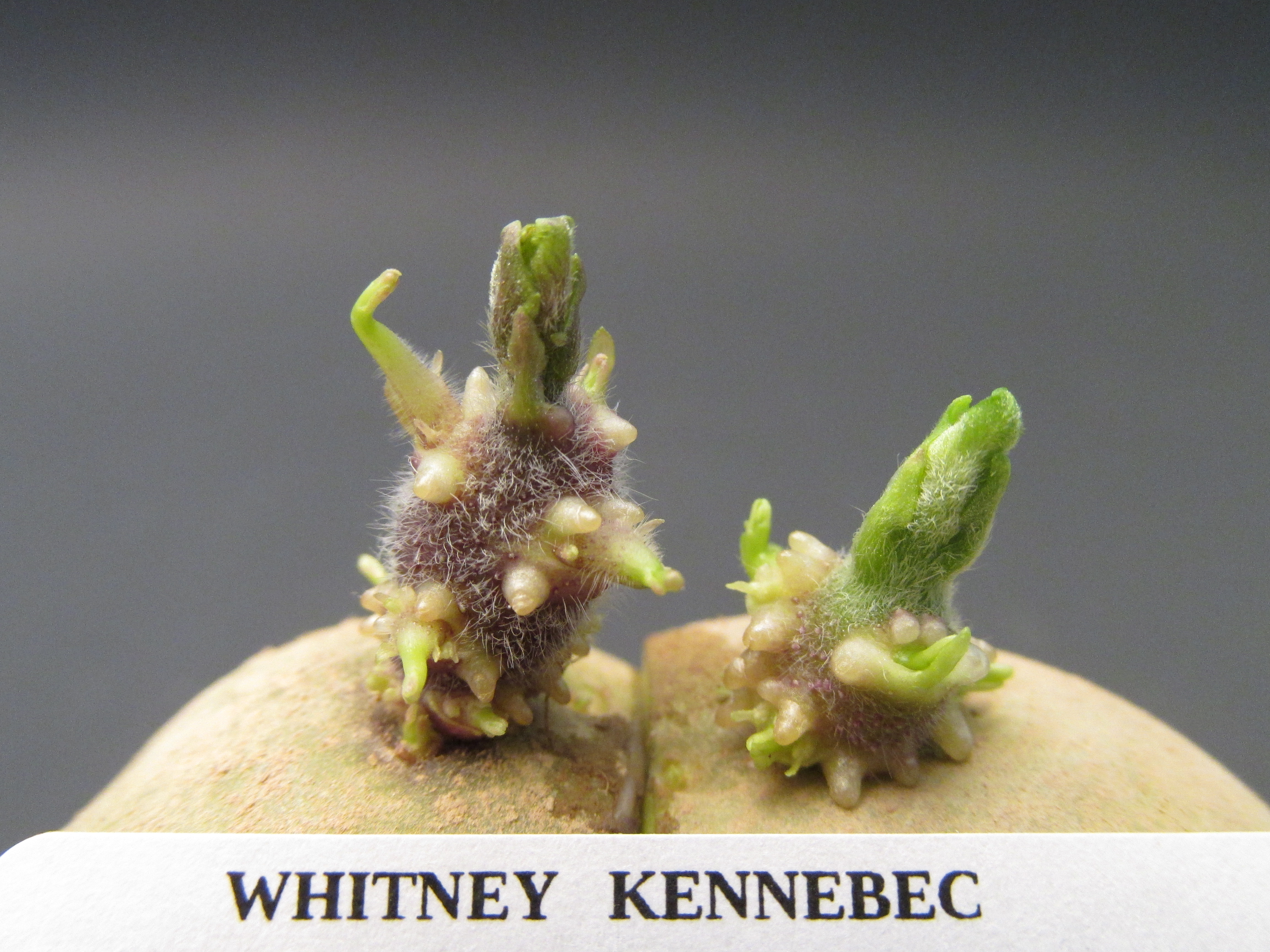Whitney
| Denomination: | 'Whitney' |
|---|---|
| Botanical Name: | Solanum tuberosum |
| Applicant/Holder: |
IPR B.V. P.O. Box 88 8500 AB Joure Netherlands |
| Breeder: |
R. P. Graveland, IPR B.V., Joure, Netherlands |
| Agent in Canada: |
HZPC-Americas Corp. PO Box 95 Winsloe, Prince Edward Island C1E 1Z2 Canada Tel: 902-892-2004 |
| Application Date: | 2013-10-18 |
| Application Number: | 13-8128 |
| Grant of Rights Date: | 2016-02-17 |
| Certificate Number: | 5193 |
| Grant of Rights Termination Date: | 2036-02-17 |
Variety Description
Variety used for comparison: 'Kennebec'
Summary: The lightsprout of 'Whitney' is broad cylindrical in shape whereas that of 'Kennebec' is ovoid. The intensity of anthocyanin colouration on the lightsprout of 'Whitney' is strong at the base and medium at the tip whereas the intensity is weak at the base and is absent or very weak at the tip of 'Kennebec'. The size of the tip of the lightsprout in relation to the base is small for 'Whitney' whereas it is medium for 'Kennebec'. The foliage structure of 'Whitney' is an intermediate type with the foliage half open and stems partly visible whereas that of 'Kennebec' is a leaf type with the foliage closed and stems not, or hardly, visible. The extent of anthocyanin colouration halfway up the stem of 'Whitney' is medium whereas it is absent or very low at the base of the stem for 'Kennebec'. The anthocyanin colouration of the flower bud is of medium extent for 'Whitney' whereas it is absent or very low for 'Kennebec'. The plant of 'Whitney' is shorter than that of 'Kennebec'. The extent of anthocyanin colouration on the peduncle and inner side of the corolla is low for 'Whitney' whereas the extent is absent or very low for 'Kennebec'. On the inner side of the corolla, the intensity of anthocyanin colouration for 'Whitney' is weak whereas it is absent or very low for 'Kennebec'. The tuber of 'Whitney' is round with shallow eyes and cream coloured flesh whereas the tuber of 'Kennebec' is short oval to oval in shape with eyes at a medium depth and white flesh.
Description:
LIGHTSPROUT: large, broad cylindrical shape, medium number of root tips, medium length of lateral shoots
LIGHTSPROUT BASE: strong intensity of anthocyanin colouration, medium proportion of blue in anthocyanin colouration, medium density of pubescence
LIGHTSPROUT TIP: small in relation to base, closed habit, medium intensity of anthocyanin colouration, medium density of pubescence
PLANT: foliage structure is intermediate between stem and leaf types were foliage is half open and stems are partly visible, semi-upright growth habit, matures mid-season
STEM: medium extent of anthocyanin colouration halfway up the stem
LEAF: outline is small to medium size, openness is intermediate between closed and open, medium green on upper side, no anthocyanin colouration on midrib of upper side, medium presence of secondary leaflets, absent or very low frequency of coalescence of terminal and lateral leaflets
SECOND PAIR OF LATERAL LEAFLETS: medium size, leaflet is as broad as it is long
LEAFLET: weak waviness of margin, medium depth of veins, dull upper side, glabrous blade at apical rosette
INFLORESCENCE: medium frequency per plant, small to medium size
PEDUNCLE: low extent of anthocyanin colouration
FLOWER BUD: medium extent of anthocyanin colouration
COROLLA: medium size, low extent and weak intensity of anthocyanin colouration on inner side, absent or low proportion of blue in anthocyanin colouration on inner side
TUBER: round shape, cream coloured flesh
TUBER EYE: shallow depth, yellow at base
TUBER SKIN: yellow, develops medium to strong intensity of anthocyanin colouration in reaction to light
Origin & Breeding History: The variety 'Whitney' originated from a cross made in 2005 between 'Sifra' as the female parent and 'Carrera' as the male parent at the HZPC Research & Development Centre in Metslawier, The Netherlands. The variety was selected from the F1 progeny in 2006. Selection criteria included internal and external quality, yield and resistance against different diseases and pests. The testing was conducted in The Netherlands and at different locations abroad.
Tests & Trials: The comparative trial for 'Whitney' was conducted during the growing season of 2014 in Drummond, New Brunswick. The trial consisted of a single row with 60 plants spaced 0.3 metres apart for each variety. The distance between rows within the trial was 0.9 metres. Observations and measurements were taken from 10 plants of each variety. Mean differences were significant at the 5% probability level based on a paired Student's t-test.
Comparison table for 'Whitney' with reference variety 'Kennebec'
Plant height (cm)
| 'Whitney' | 'Kennebec' | |
|---|---|---|
| Mean | 38.0 | 50.6 |
| std. deviation | 2.8 | 1.4 |
Click on image for larger view

Potato: 'Whitney' (left) with reference variety 'Kennebec' (right)
- Date modified: